- The Importance of Whitewashing Trees in Spring
- Protection from Sunscald
- Prevention of Insect Damage
- Protection from Frost
- Enhancing Aesthetic Appeal
- Choosing the Right Whitewashing Solution
- Consider the Type of Tree
- Choose the Right Additives
- Consult with Professionals
- Preparing the Tree for Whitewashing
- Applying the Whitewashing Solution
- Step 1: Prepare the Tree
- Step 2: Start from the Bottom
- Step 3: Use a Brush or Sprayer
- Step 4: Apply Generously
- Step 5: Allow to Dry
- Step 6: Reapply as Needed
- Techniques for Whitewashing Different Types of Trees
- 1. Evergreen Trees
- 2. Fruit Trees
- 3. Deciduous Trees
- Whitewashing Tips for Maximizing Effectiveness
- 1. Choose the Right Time
- 2. Prepare the Tree
- 3. Select the Right Whitewash
- 4. Apply the Whitewash Properly
- 5. Reapply as Needed
- 6. Consider Additional Protection
- 7. Monitor for Pests and Diseases
- 8. Watch for Signs of Damage
- 9. Educate Others
- 10. Consult an Expert
- Frequently Asked Questions about Tree Whitewashing
- Question-answer:
- Why do people whitewash trees in spring?
- What materials are used for tree whitewashing?
- How can I make my own whitewash for trees?
- When is the best time to whitewash trees?
- How often should I whitewash my trees?
- Is whitewashing trees necessary?
- Video: How to Water Your Fruit Trees and Plants LOW MAINTENANCE | Drip Irrigation Walkthrough and Tour
As spring arrives, many gardeners and tree enthusiasts turn their attention to the care and maintenance of their beloved trees. One important practice that often goes overlooked is whitewashing. Whitewashing is the process of applying a lime-based solution to the trunk and branches of trees to protect them from various environmental factors and promote their health. In this guide, we will explore the benefits of whitewashing trees in spring and provide some effective techniques to help you achieve optimal results.
Whitewashing serves multiple purposes when it comes to tree care. First and foremost, it acts as a protective barrier against harmful elements such as severe temperatures, excessive sunlight, and pests. By reflecting sunlight, the whitewash helps to prevent sunburn and the subsequent cracking and damage to the tree’s bark. Additionally, the lime-based solution repels insects and pests, reducing the risk of infestation and disease.
Furthermore, whitewashing can significantly improve the overall appearance of trees. A fresh coat of whitewash not only gives trees a clean and polished look, but it also enhances their visibility, especially in low-light conditions. This is particularly important for road-facing or landmark trees, as it helps to increase their visibility and reduce the risk of accidents.
Now that we understand the importance of whitewashing trees, let’s explore some effective techniques for achieving optimal results. To begin, it is crucial to prepare the tree by cleaning the trunk and branches. This can be done using a soft brush and water, gently removing any debris or loose bark. Once the tree is clean and dry, it’s time to apply the whitewash.
Pro tip: When applying the whitewash, start from the bottom of the tree and work your way up. This ensures even coverage and prevents the solution from dripping onto already whitewashed areas.
There are several options when it comes to choosing a whitewash solution. Traditional whitewash consists of a mixture of lime, water, and salt. This mixture can be easily prepared at home or purchased from a garden center. Alternatively, there are commercial whitewash products available that are specifically formulated for tree care. Regardless of the solution you choose, make sure it is non-toxic and safe for the environment.
Once you have the whitewash ready, apply it using a brush or spray bottle. Make sure to cover the entire trunk and branches, paying special attention to any wounds or exposed areas. The whitewash should be applied in a thick and even layer, ensuring that the tree is fully protected. Allow the whitewash to dry completely before watering the tree or exposing it to rain.
By following these techniques for effective tree whitewashing, you can protect and enhance the health and beauty of your trees. Remember to repeat the whitewashing process annually, preferably in early spring, to maintain optimal results. With proper care and attention, your trees will thrive and continue to bring joy and beauty to your outdoor space for years to come.
The Importance of Whitewashing Trees in Spring
Whitewashing trees in spring is an important practice for the health and well-being of trees. It involves applying a mixture of water, lime, and other materials to the trunks and branches of trees to protect them from various factors that can cause harm.
Protection from Sunscald
- One of the main reasons why whitewashing trees in spring is important is to protect them from sunscald. Sunscald occurs when the temperature fluctuates rapidly between warm and cold, causing the bark to crack and split. Whitewashing helps to reflect the sunlight and prevent the bark from overheating, reducing the risk of sunscald.
Prevention of Insect Damage
- Whitewashing trees also acts as a barrier against insects such as borers and tree beetles. These insects are attracted to the dark color of tree bark, as it provides them with a suitable environment for nesting and feeding. By applying a whitewash, the insects are less likely to settle on the tree, reducing the risk of infestation and damage.
Protection from Frost
- In regions where spring frost is a concern, whitewashing trees can help protect them from the damaging effects of frost. The white color reflects the sunlight and reduces heat absorption, preventing the tree from reaching freezing temperatures. This can help prevent frost damage to the buds and young shoots of the tree.
Enhancing Aesthetic Appeal
- Aside from the practical benefits, whitewashing trees in spring can also enhance the aesthetic appeal of the landscape. It gives the trees a clean and tidy appearance, making them more visually appealing. This can be particularly important in urban environments where the appearance of trees can greatly affect the overall aesthetic of the area.
Overall, whitewashing trees in spring is a simple and effective technique for promoting the health and longevity of trees. By providing protection against sunscald, insect damage, frost, and enhancing their aesthetic appeal, whitewashing can significantly contribute to the well-being and beauty of trees.
Choosing the Right Whitewashing Solution
When it comes to whitewashing your trees in the spring, it is important to choose the right whitewashing solution. The right solution will not only effectively protect your trees but also provide other benefits, such as insect repelling or moss control.
Consider the Type of Tree
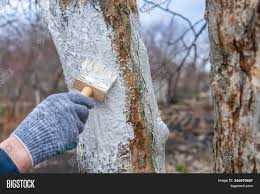
Before selecting a whitewashing solution, consider the type of tree you are working with. Different trees may have different needs and may respond differently to whitewashing solutions.
Deciduous Trees: Deciduous trees shed their leaves in the fall, and their bark may be more susceptible to sunburn or insect damage in the spring. For these trees, a thicker and more opaque whitewashing solution is recommended.
Evergreen Trees: Evergreen trees retain their green foliage year-round and have a different type of bark than deciduous trees. They are more resilient to sunburn and pest infestations. For these trees, a thinner and more translucent whitewashing solution is usually sufficient.
Choose the Right Additives
In addition to the base whitewashing solution, you may also consider adding certain additives to enhance its effectiveness. These additives can provide extra benefits and address specific issues:
- Insect Repellents: If your trees are prone to insect infestations, you can add insect repellents, such as neem oil or citronella, to the whitewashing solution. This will help deter pests and protect your trees from damage.
- Moss Control: If you notice moss growing on your tree’s bark, you can add a moss control additive to the whitewashing solution. This will help prevent the growth of moss and keep your tree healthy.
- Sunscreen: Some whitewashing solutions come with built-in sunscreen properties to protect your trees from excessive sun exposure. This is particularly beneficial for trees that are more susceptible to sunburn.
Consult with Professionals

If you are unsure about which whitewashing solution to choose, it is always a good idea to consult with professionals, such as arborists or gardening experts. They can provide guidance based on your specific tree species and local climate conditions.
Remember, choosing the right whitewashing solution is crucial for effectively protecting your trees and ensuring their health. By considering the type of tree, choosing the right additives, and seeking professional advice if needed, you can make an informed decision and achieve the best results.
Preparing the Tree for Whitewashing
Before you begin whitewashing your tree, it’s important to properly prepare the tree to ensure the best results. Here are some steps to follow:
- Clean the tree trunk: Use a soft brush or cloth to gently remove any dirt, debris, or loose bark from the trunk of the tree. This will provide a clean surface for the whitewash to adhere to. Avoid using any harsh brushes or scraping tools that could damage the tree.
- Trim any dead or diseased branches: Take the time to inspect the tree and remove any dead or diseased branches. This will not only improve the tree’s overall health, but it will also enhance the aesthetic appeal of the whitewashing.
- Treat any existing pests or diseases: If you notice any signs of pests or diseases on the tree, it’s important to address these issues before applying the whitewash. Consult with a professional arborist or tree specialist to determine the best course of action.
- Choose the right weather conditions: Whitewashing is most effective when done during the spring or fall seasons, when the tree is not actively growing. Avoid applying the whitewash during periods of high humidity or extreme temperatures, as this can affect the drying process.
- Protect surrounding areas: Before applying the whitewash, cover the ground and any nearby plants or structures with drop cloths or plastic sheets. This will prevent any unwanted staining or damage from the whitewash.
- Mix the whitewash solution: Follow the instructions provided with your chosen whitewash product to mix the solution. Typically, whitewash consists of water, lime, and a binder. Mix the solution thoroughly to ensure a smooth and consistent mixture.
By properly preparing your tree for whitewashing, you can ensure that the whitewash adheres well and provides the desired benefits. Take the time to follow these steps, and your tree will be ready for a fresh coat of whitewash.
Applying the Whitewashing Solution
Once you have prepared the whitewashing solution, which typically consists of water, lime, and a binder such as glue or salt, you are ready to apply it to your trees. Follow these steps to ensure effective whitewashing:
Step 1: Prepare the Tree
Before applying the solution, make sure the tree is free from any debris or loose bark. Use a soft brush or cloth to gently remove any dirt or dust from the tree’s surface. This will help the whitewashing solution adhere properly.
Step 2: Start from the Bottom
Begin applying the whitewashing solution from the bottom of the tree and work your way up. This will prevent the solution from dripping onto previously whitewashed areas and ensure a more even coverage.
Step 3: Use a Brush or Sprayer
You can apply the whitewashing solution using a brush or a sprayer, depending on your preference. If using a brush, make sure to choose one with soft bristles to avoid damaging the tree’s bark. A sprayer can provide a more efficient and uniform application.
Step 4: Apply Generously
Ensure that you apply the whitewashing solution generously, covering the entire surface of the tree. This will provide maximum protection against sunscald and other weather-related damages.
Step 5: Allow to Dry
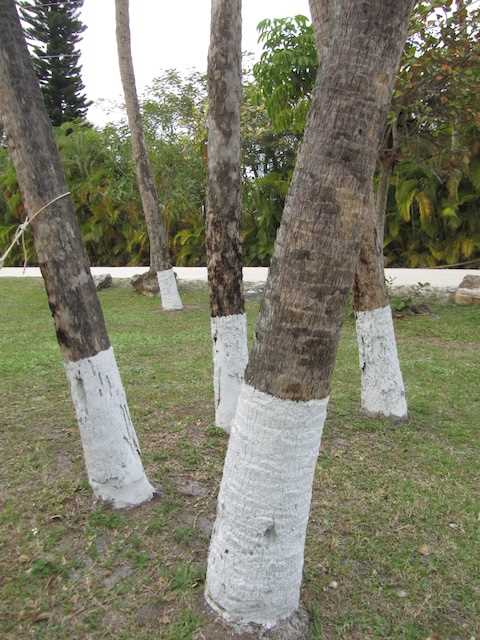
Once you have applied the whitewashing solution, allow it to dry completely before touching or watering the tree. This usually takes a few hours or overnight, depending on the weather conditions.
Step 6: Reapply as Needed
Over time, the whitewashing solution may fade or wear off. Monitor your trees regularly and reapply the whitewash as needed, especially after heavy rain or extreme weather conditions.
By following these steps, you can effectively apply the whitewashing solution to your trees and help protect them during the spring season.
Techniques for Whitewashing Different Types of Trees
Whitewashing trees is an effective way to protect their bark and trunks from sun damage, pests, and disease. However, different types of trees may require slightly different techniques for whitewashing to ensure optimal coverage and protection. Here are some useful techniques for whitewashing different types of trees:
1. Evergreen Trees
- Start by thoroughly cleaning the bark of the evergreen tree to remove any dirt or debris.
- Mix a whitewash solution using equal parts of water, latex paint, and powdered lime.
- Apply the whitewash mixture to the bark using a brush or roller, making sure to cover the entire trunk and lower branches.
- Allow the whitewash to dry completely before applying a second coat if needed.
2. Fruit Trees
- Clean the bark of the fruit tree by gently scrubbing it with a mild detergent and water.
- In a bucket, combine equal parts water and powdered lime, and mix well.
- Apply the lime mixture to the bark using a brush or sprayer, being careful to cover all exposed areas.
- Allow the whitewash to dry completely before applying additional coats for added protection.
3. Deciduous Trees
- Remove any loose or peeling bark from the deciduous tree to create a smooth surface.
- Create a whitewash mixture by combining water, exterior latex paint, and powdered chalk.
- Apply the whitewash to the bark using a brush, working in long, smooth strokes from the bottom up.
- Ensure that the entire trunk and main branches are covered with the whitewash.
- Allow the whitewash to dry thoroughly before adding an additional coat if necessary.
Remember to avoid whitewashing trees during rainy or windy weather, as it can affect the drying process and the overall effectiveness of the whitewash. Additionally, always use protective gear, such as gloves and safety goggles, when applying whitewash to protect yourself.
Whitewashing Tips for Maximizing Effectiveness
1. Choose the Right Time
Timing is crucial when it comes to whitewashing trees. The best time to apply whitewash is in early spring or late fall, when the weather is cool and the tree is in a dormant state. This ensures that the whitewash will adhere properly and provide long-lasting protection.
2. Prepare the Tree
Before applying the whitewash, it is important to prepare the tree properly. Start by cleaning the trunk and branches, removing any dirt, debris, or loose bark. This will ensure that the whitewash adheres properly and provides maximum protection.
3. Select the Right Whitewash
There are various types of whitewash available, including commercial products and homemade recipes. It is important to select a whitewash that is specifically formulated for trees, as this will provide the best protection. Look for a whitewash that is non-toxic and environmentally friendly.
4. Apply the Whitewash Properly
When applying the whitewash, it is important to do so in thin, even coats. Use a brush or roller to apply the whitewash, starting at the bottom of the tree and working your way up. Make sure to cover the entire trunk and branches, as well as any exposed roots.
5. Reapply as Needed
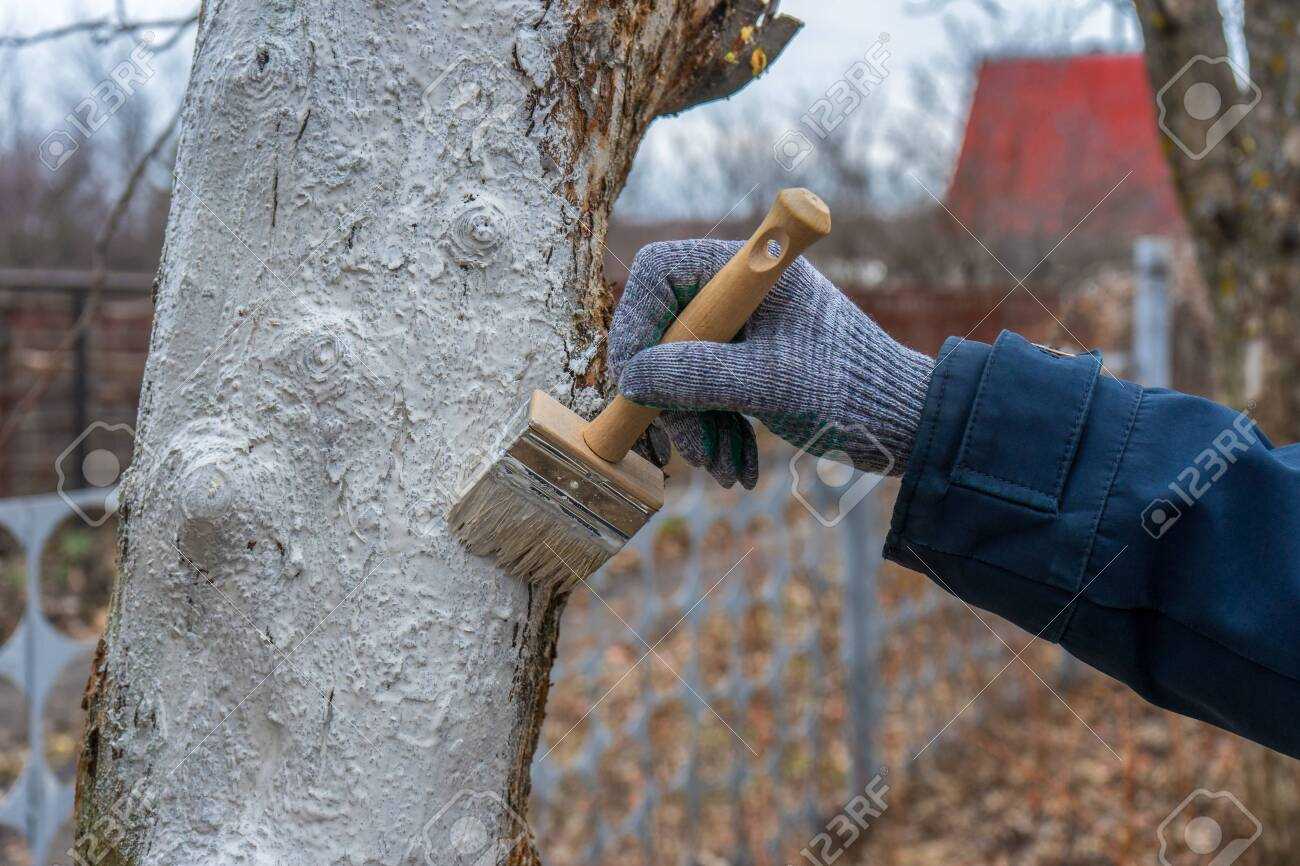
Whitewash is not a permanent solution and will eventually wear off. It is important to monitor the condition of the whitewash and reapply it as needed. This is especially important in areas with harsh weather conditions, as the whitewash may need to be reapplied more frequently.
6. Consider Additional Protection
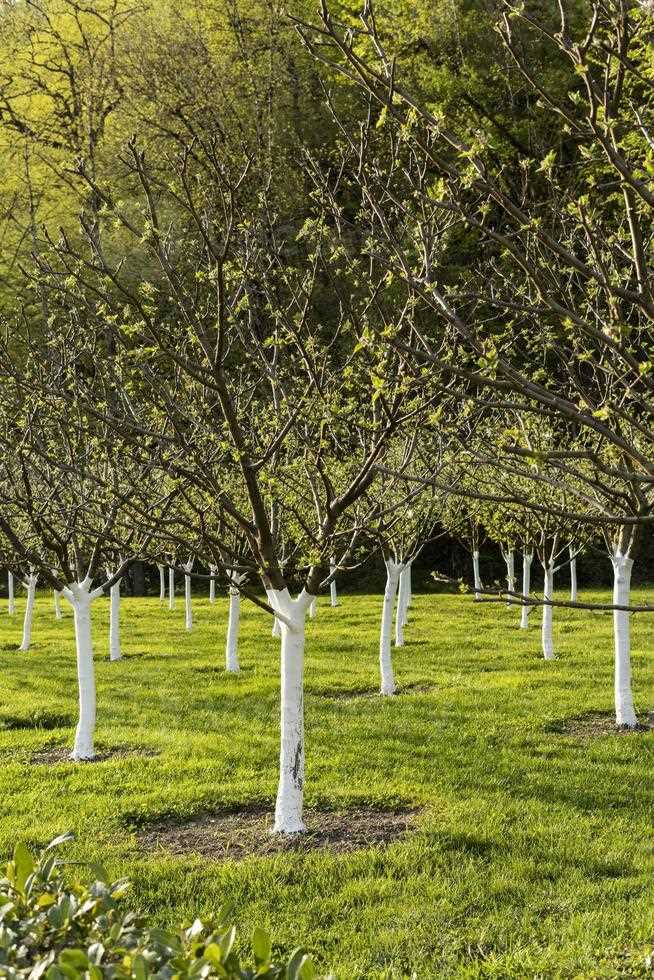
In addition to whitewashing, there are other ways to protect trees and promote their health. Consider applying a protective sealant or wrapping the trunk with burlap during harsh winter months. Also, make sure to provide proper watering and fertilization to support the tree’s overall health.
7. Monitor for Pests and Diseases
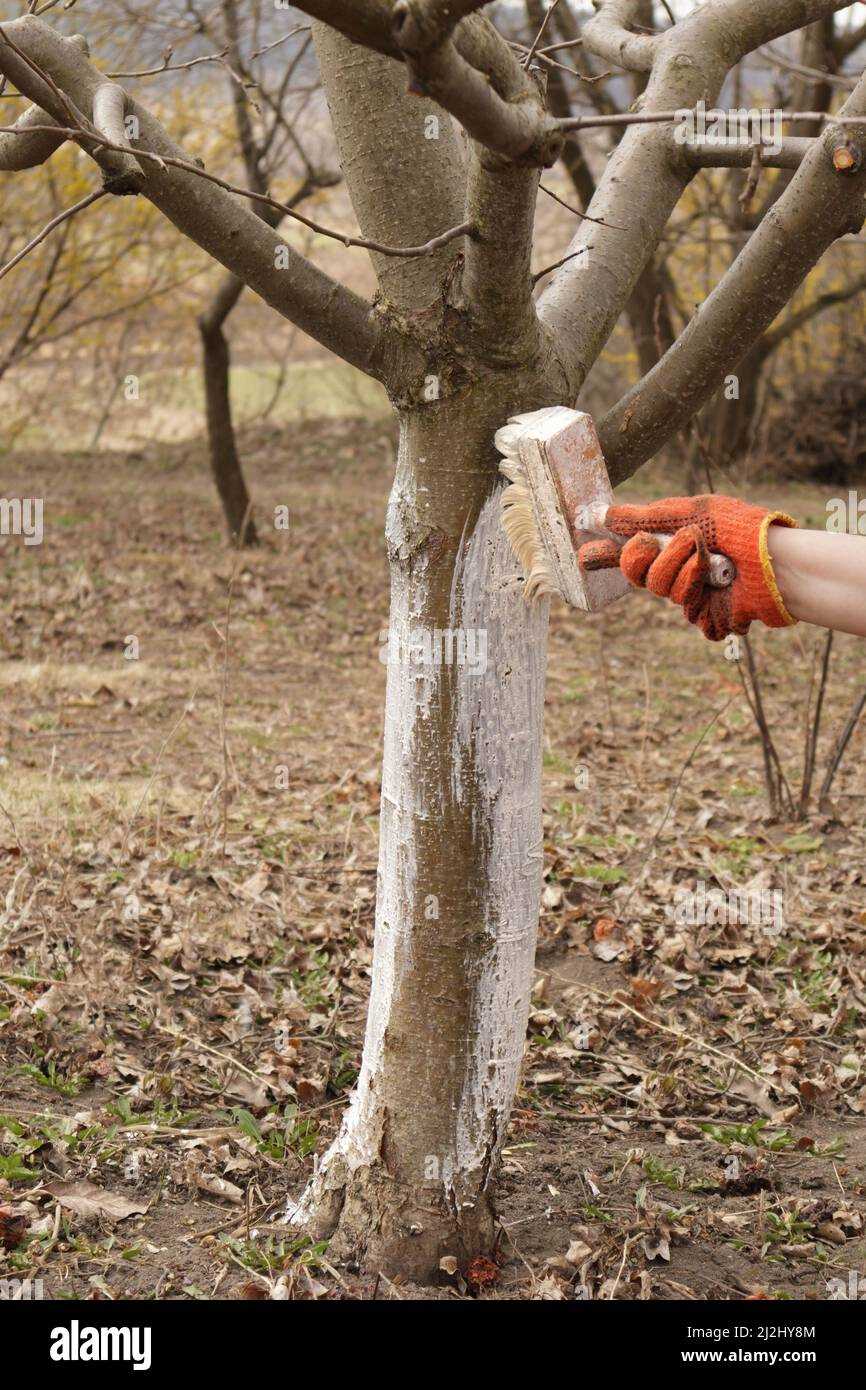
Regularly inspect the tree for signs of pests or diseases. Whitewashing can help deter some pests, but it is not a foolproof method. If you notice any signs of infestation or disease, take appropriate action by consulting with a professional arborist or using environmentally friendly pest control measures.
8. Watch for Signs of Damage
Keep an eye out for signs of damage, such as cracking or peeling of the whitewash, or any changes in the tree’s health. If you notice any issues, take prompt action to address them and protect the tree’s overall well-being.
9. Educate Others
Spread the word about the benefits of whitewashing trees to your friends, neighbors, and community. Whitewashing is not just a cosmetic treatment, but an effective way to protect trees from sunburn, pests, diseases, and extreme weather conditions. By educating others, you can help promote the health and longevity of trees in your area.
10. Consult an Expert
If you are unsure about the proper whitewashing technique or need advice on tree care, consult with a professional arborist or horticulturist. They can provide personalized recommendations based on your specific tree species, climate, and other factors.
Frequently Asked Questions about Tree Whitewashing
1. What is tree whitewashing?
Tree whitewashing is the practice of applying a lime-based or latex-based whitewash to the trunk and branches of trees. This protective coating helps to prevent sunscald and heat stress, as well as deter insects and diseases.
2. When should I whitewash my trees?
It is recommended to whitewash trees in the early spring, just before new growth begins. This helps to protect the bark from the intense sunlight and temperature fluctuations that occur during the spring season.
3. What materials do I need for tree whitewashing?
To whitewash trees, you will need a lime-based or latex-based whitewash solution, a paintbrush or sprayer for application, and protective clothing, such as gloves and goggles, to prevent skin and eye irritation.
4. How do I apply the whitewash solution?
You can apply the whitewash solution using a paintbrush or sprayer. Start at the base of the tree and work your way up, making sure to cover the trunk and branches evenly. Avoid getting the solution on the leaves or other nearby vegetation.
5. How often should I whitewash my trees?
It is recommended to whitewash trees once a year, preferably in the early spring. However, if you notice any signs of sunscald or damage to the bark, you may need to reapply the whitewash more frequently.
6. Can I use any type of paint for tree whitewashing?
No, it is important to use a specific lime-based or latex-based whitewash solution that is designed for tree whitewashing. Regular paint may not provide the same level of protection and could be harmful to the tree.
7. Will tree whitewashing improve the health of my trees?
While tree whitewashing can help to protect the bark from sunscald and heat stress, it is not a cure-all for tree health issues. It is important to also provide proper care and maintenance, such as watering, pruning, and fertilizing, to ensure the overall health of your trees.
8. Can I whitewash fruit trees?
Yes, you can whitewash fruit trees. However, it is important to use a whitewash solution that is safe for edible plants. Avoid getting the solution on the fruit or any other edible parts of the tree.
| Product | Type |
|---|---|
| Lime-Sulfur Whitewash | Lime-based |
| Latex Whitewash | Latex-based |
Question-answer:
Why do people whitewash trees in spring?
People whitewash trees in spring to protect the bark and foliage from the harsh effects of the sun. The whitewash acts as a reflective barrier and helps to regulate the temperature of the tree, preventing sunburn and heat stress.
What materials are used for tree whitewashing?
There are various materials that can be used for tree whitewashing. Lime-based whitewash is a common choice, as it is environmentally friendly and has a high reflectivity. Other options include clay-based whitewash and commercial whitewashing solutions.
How can I make my own whitewash for trees?
To make your own whitewash for trees, you can mix lime or clay with water to create a paste-like consistency. Add a small amount of liquid detergent to help the mixture adhere to the tree. Alternatively, you can purchase commercial whitewashing solutions from gardening stores.
When is the best time to whitewash trees?
The best time to whitewash trees is in early spring, before the new growth starts to emerge. This gives the whitewash enough time to dry and create a protective barrier before the sun becomes too intense. It is important to avoid whitewashing trees during rainy or humid weather, as it may interfere with the drying process.
How often should I whitewash my trees?
The frequency of whitewashing trees depends on various factors, such as the climate and the tree species. In general, it is recommended to whitewash trees once a year, preferably in early spring before the new growth begins. However, if you notice that the whitewash is starting to fade or peel, it is a sign that it needs to be reapplied.
Is whitewashing trees necessary?
Whitewashing trees is not necessary for all tree species. However, it can be beneficial, especially for young or newly planted trees, as it helps protect their delicate bark and foliage from sunburn and heat stress. Additionally, whitewashing can act as a deterrent for pests and discourage them from laying eggs on the tree.







